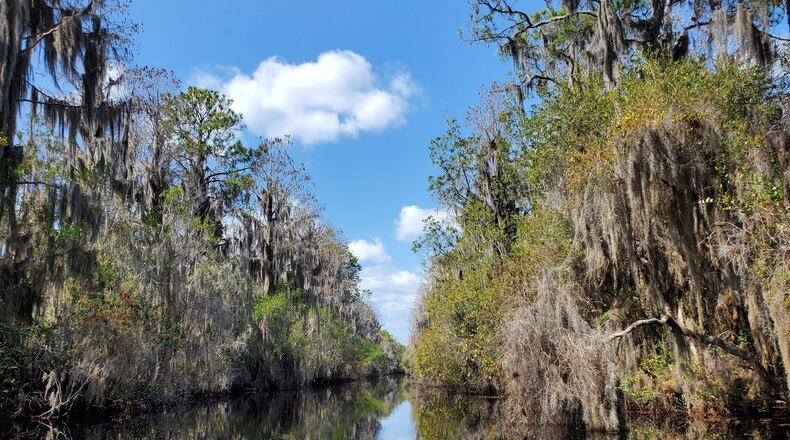Federal scientists have delivered their most detailed critique yet of an Alabama company’s plan to mine near the Okefenokee National Wildlife Refuge, casting serious doubt on the claims of the company and state environmental regulators, who have repeatedly said the project poses no harm to the refuge.
The new analysis by hydrologists at the National Park Service (NPS) found ‘critical shortcomings’ in the model the company used, which they say “obfuscates the true impacts from mining on the refuge.” As a result, the scientists say the model cannot reliably predict how water levels in the swamp or surrounding ecosystems will be affected by the mine.
The findings are likely to give new ammunition to opponents of the project, who have argued for years that the strip mine — planned less than three miles from the Okefenokee’s edge — would permanently damage the fragile ecosystem.
Meanwhile, a separate letter from the U.S. Fish and Wildlife Service (FWS) — the agency responsible for protecting the refuge’s plants and animals — questions whether the project needs a full federal environmental review to proceed, rather than the state permitting process it’s currently required to clear.
Last year, the U.S. Army Corps of Engineers settled a lawsuit filed against it by Twin Pines Minerals LLC, the company seeking to develop the mine. The agreement removed all federal oversight of the mine and left the Georgia Environmental Protection Division (EPD) in charge of reviewing the company’s plans.
The assessment and letter were submitted to EPD in the final days of the public comment period on Twin Pines’ mining plan, which ended Monday.
Georgia EPD spokeswoman Sara Lips said the agency is still tallying written letters, but more than 77,000 comments were received during the 60-day period. That’s on top of the nearly 27,000 comments submitted in the months before the company’s plans were released publicly.
Lips said EPD would not respond to questions about technical comments until after staff has completed its review.
Twin Pines President Steve Ingle said the company is aware of the scientists’ analysis and the letter, and said the company would respond in future submissions to Georgia regulators.
Ingle said it was clear some of the critique is “based on incorrect or incomplete information, but in other cases, we simply disagree and will explain why.” He added that the company remains “committed to working with the scientists at EPD to provide any additional information needed to eliminate doubt.”
‘Several inadequate assumptions’
Twin Pines is seeking permits to extract titanium dioxide from an ancient sand dune complex that runs along the eastern boundary of the refuge. The company says its modeling shows the strip mining it plans to conduct on 580 acres will not harm the swamp.
But in their detailed breakdown, the NPS scientists say that conclusion is based on a flawed model that fails to capture the full potential impact of the mine on the swamp.
“Several inadequate assumptions in the model collectively compromised the modeling capability to accurately predict the impacts on ONWR (Okefenokee National Wildlife Refuge),” wrote Kiren Bahm and Rajendra Paudel, the NPS hydrologists.
The company’s plans call for drilling two wells in the Floridan Aquifer — the same aquifer that underlies the Okefenokee — capable of pumping a maximum of 1,000 gallons of groundwater per minute. That water would be used primarily at the start of the mining process to fill four “process water” ponds with a maximum capacity of 3.9 million gallons.
But the NPS scientists say the equation the company’s contractors used to gauge the effect of that pumping is “too simplistic” to accurately predict whether water levels in the swamp could be lowered.
The scientists also claim the company did not include enough of the watershed surrounding the mine in its modeling, leaving out areas where water flows between the site and the Okefenokee.
In conclusion, the scientists wrote that, “The modeling and analysis did not sufficiently prove that ONWR will not be affected by the proposed mining operation.”
Is a federal permit needed?
A letter written by a U.S. Fish and Wildlife Service (FWS) official that accompanied the analysis argues the scientists’ new findings show the project may impact federally protected waters after all.
If true, that would mean the mine would need to obtain a federal Clean Water Act permit from the U.S. Army Corps of Engineers (USACE), a process that could take years and cost Twin Pines millions of dollars.
In his letter, the FWS’ acting Southeast regional director Mike Oetker calls on Georgia EPD to suspend any action on Twin Pines’ permits until after the Corps can determine whether a federal permit is needed.
“The critical shortcomings of the modeling identified in the report are so significant that the USACE could not have made an appropriate determination...,” Oetker wrote.
The Corps referred questions from The Atlanta Journal-Constitution about the letter to the U.S. Department of Justice, who did not immediately respond to a request for comment.
Georgia EPD said it would not weigh in, saying it is still reviewing technical comments it has received.
This is not the first time that federal officials have expressed grave concerns about the potential impact of the Twin Pines mine on the Okefenokee, despite having no formal oversight of the project currently.
In November, U.S. Interior Secretary Deb Haaland wrote a letter to Gov. Brian Kemp, saying the mine poses an “unacceptable risk” to the swamp and calling on the state to stop the project. Haaland also visited the swamp last year with U.S. Sen. Jon Ossoff, who has also called on EPD to reject Twin Pines’ permits.
State’s permit review continues
In the meantime, the state’s permitting process continues to roll on.
EPD spokeswoman Lips said the agency will publish a public document responding to technical feedback it received during the public comment period. Lips said it could take anywhere from several days to several months to compile the responses.
Once that is complete, EPD could release the air, water and mining draft permits as a group. That would trigger another public comment period.
A bipartisan bill in the Georgia General Assembly that would prevent future mining permits from being issued near the swamp also appears unlikely to impact the project’s trajectory, at least for now.
That bill, House Bill 71, received a long-awaited hearing in the House Natural Resources and Environment’s Resource Management Subcommittee last week. But the bill failed to pass the full chamber before a deadline earlier this month and appears to be stalled until next session.
Its sponsor, Darlene Taylor (R-Thomasville), has proposed a separate resolution that would create a study committee to examine threats to the swamp. It remains unclear whether that measure will pass this session either.
This coverage is supported by a partnership with 1Earth Fund, the Kendeda Fund and Journalism Funding Partners. You can learn more and support our climate reporting by donating at ajc.com/donate/climate/
About the Author
Keep Reading
The Latest
Featured



